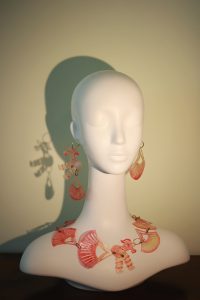Discover the marriage of shadow puppetry and style, as ancient art gets a modern makeover.
By Zora Yan
Jewellery designer Zhang Jielu transformed traditional shadow puppets into trendy-fashion jewellery to let more young people know about this handicraft.
Drawing inspiration from mythical creatures such as a fish with six legs and a bird-like tail, mountain gods and more from the ancient Chinese mythology book ‘Shan Hai Jing,’ Zhang had made 10 jewellery pieces including masks, headpieces, earrings, necklaces, and handbags.
These wearable artworks made with materials used in shadow puppets were showcased at the 2022 Toronto Art Fashion Week.
“It is a significant breakthrough of innovation in traditional craftsmanship as nobody has tried it before,” Zhang says.
Zhang says shadow puppetry, originating in the Xi Han dynasty(202 BC-9 AD), is a genre of Chinese traditional folk drama that uses animal skins to create characters and tell stories, accompanied by music and singing.
Illuminated from behind, these puppets project colourful images on a translucent sheet.
Having completed her studies in jewellery design at Central Saint Martins College of Art and Design in London, Zhang believes it is a pity shadow puppetry is only perceived as a tradition seen in museums.

She was intrigued by traditional arts after visiting the Chengdu Shadow Puppet Museum in 2019 as she was attracted by the material used for shadow puppetry with its vibrant colours and impressive transparency.
“So, I decided to transform shadow puppetry into a cool form of art to let more people learn about and love this intangible cultural heritage,” the 34-year-old designer says.
She spent ten months consulting professional craftsmen and researching online to learn the puppet-making basics.
“Before learning, I thought that cowhide should be relatively soft, but actually it is very hard and not easy to shape,” Zhang says.
The designer also explores innovative methods that can modernize this handicraft.
She breaks down the tradition of shadow puppetry in five ways: transforming its presentation from 2D to 3D, changing its imagery from concrete to abstract, altering the use of solid colours to mixed ones, incorporating new materials, and integrating it with wearable objects.
In 2021, Zhang started running her second studio, focusing on making ‘new shadow puppets’ that can be worn, such as earrings, bracelets, necklaces, and bags.
She thinks her jewellery can attract young people to learn more about the traditional handcraft, which usually can only be found in theatre.

Zhang also organised workshops to introduce the history of shadow puppets to people of all ages by introducing new forms of this handicraft, such as making shadow puppets into bookmarks.
The designer believes turning shadow puppets into items that can be used in everyday life is the best way to keep the culture alive.
A master of shadow puppetry craft Wang Haitao also says presenting shadow puppetry in diverse forms can improve people’s understanding of this intangible cultural heritage.
Born and raised in Huaxian in Shaanxi Province, the birthplace of shadow puppetry, Wang started learning the craft from his father at the age of 14. He immediately realised that shadow puppets can be presented in many forms when he turned the Chinese cartoon characters Calabash Brothers into shadow puppets.
“I brought the puppets to my school. Everybody loved them! “he says, recalling the joyful moment from 24 years ago.

He says people merely think shadow puppets are simply made of cutting out various shapes from cowhide.
“In 2018 we collaborated with Fendi to create a round-shaped logo that incorporates unique snowflake patterns inspired by traditional Chinese shadow puppetry,” the 38-year-old man says.
He points out that many unique carving patterns, such as snowflakes, swastikas, and peonies, usually used in making shadow puppets, can be applied to many other products, such as cups, umbrellas, and brooches.
Wang also believes that not only patterns but also images of shadow puppet characters can be combined with innovative and modern popular images.
Many gaming companies have approached Wang to create shadow puppet versions of game characters, such as Sun Ce and Sun Shangxiang from Tencent’s Honor of Kings and various game scenes showcased in NetEase’s Fantasy Westward Journey.
Wang believes the continuous innovation of shadow puppetry can beat stereotypes and allow more people to understand this intangible cultural heritage.
Edited by Sean Pan
Sub-edited by Lorraine Chiang







































